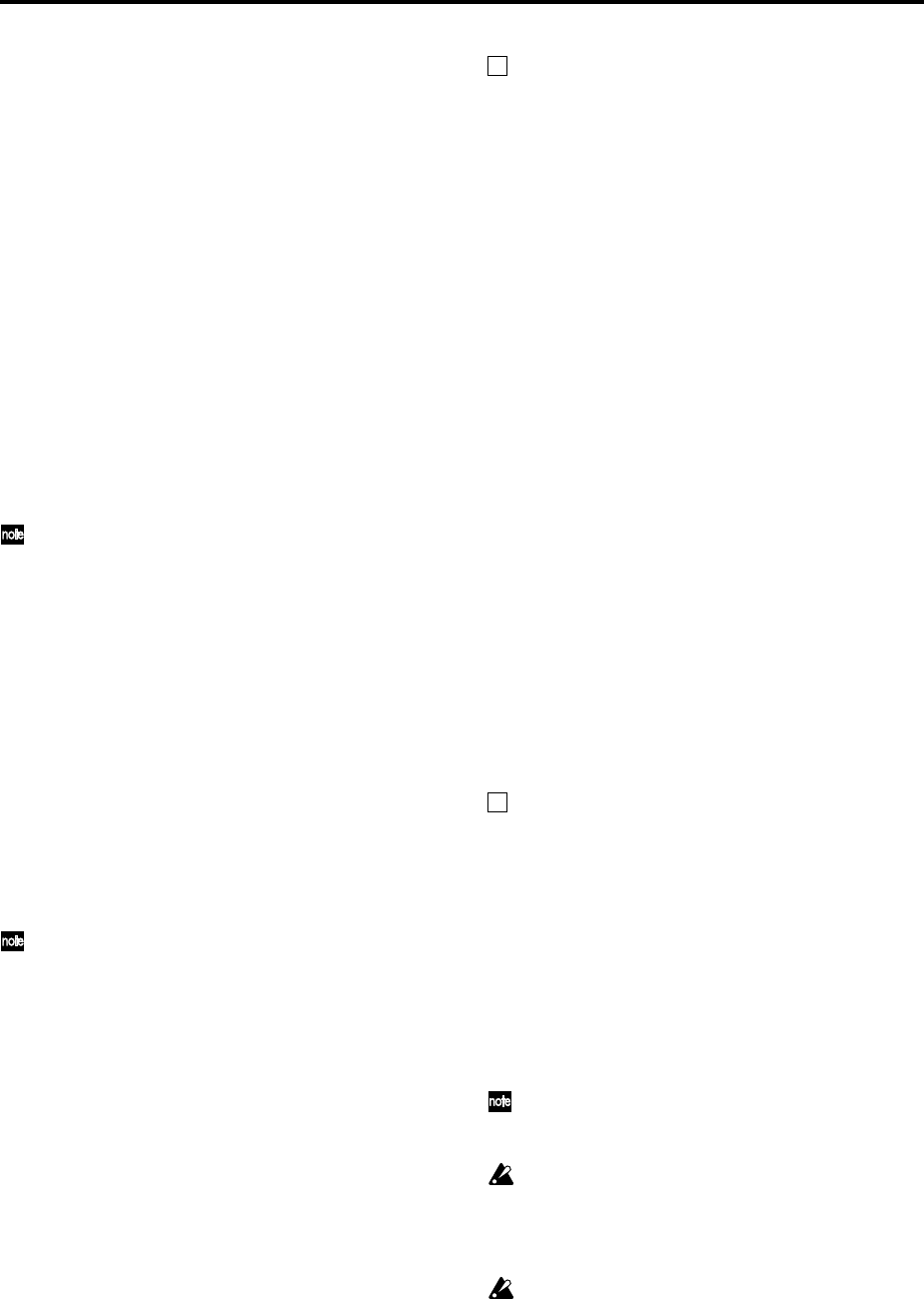
264
2 Use data entry MSB (CC#6) [Bn, 06, mm] and data entry
LSB (CC#38) [Bn, 26, vv] (n: channel, mm, vv: upper and
lower bytes of the value, together expressing 16,384 lev-
els) to specify the value.
3 You can use data increment (CC#96) [Bn, 60, 00] or data
decrement (CC#97) [Bn, 61, 00] (n: channel, value is fixed
at 00) to change the value in steps of one.
The TRITON STUDIO can receive the following three RPN
messages (tuning, transpose, and pitch bend range).
Tuning
RPN fine tune [Bn, 65, 00, 64, 01]
This RPN message can be used to adjust the detuning for a
program or timbre (in Combination mode), or for a track (in
Sequencer or Song Play modes).
The procedure is as follows.
1 [Bn, 65, 00, 64, 01]: Select RPN parameter 01.
2 [Bn, 06, mm, 26, vv]: Use data entry to set the value. A
value of 8192 [mm, vv=40, 00] is center, 0 [mm, vv=00, 00]
is -100 cents, and 16383 [mm, vv=7F, 7F] is +99 cents.
You can use the universal exclusive Fine Tune message
to adjust the overall tuning that corresponds to the
“Master Tune” (Global P0: 0–1a) parameter. (“About
system exclusive messages” ☞p.264)
Transposing
RPN coarse tune [Bn, 65, 00, 64, 02]
This RPN message can be used to adjust the transposition
for a program or timbre (in Combination mode), or for a
track (in Sequencer or Song Play modes).
The procedure is as follows.
1 [Bn, 65, 00, 64, 02]: Select RPN parameter 02.
2 [Bn, 06, mm, 26, vv]: Use data entry to set the value. Nor-
mally only the upper byte is used.
A value of 8192 [mm, vv=40, 00] is center, 6656 [mm, vv=34,
00] is –12 semitones, and 9728 [mm, vv=4C, 00] is +12 semi-
tones.
You can use the universal exclusive Coarse Tune mes-
sage to adjust the overall tuning that corresponds to the
“Transpose” (Global P0: 0–1a) parameter. (“About sys-
tem exclusive messages” ☞p.264)
Changing the pitch bend range
RPN pitch bend range [Bn, 64, 00, 65, 00]
This RPN message can be used to adjust the pitch bend
range for a program or timbre (in Combination mode) or for
a track (in Sequencer or Song Play modes).
The procedure is as follows.
1 [Bn, 65, 00, 64, 00]: Select RPN parameter 00.
2 [Bn, 06, mm, 26, vv]: Use data entry to set the value. Nor-
mally only the upper byte is used.
A value of 0 [mm, vv=00, 00] is +00, and a value of 1536
[mm, vv=0C, 00] is +12 (one octave). Although it is possible
to set a negative value for a timbre/track, only positive val-
ues can be set using RPN messages.
Controlling the arpeggiator (NPRN)
Arpeggiator operations can be controlled using NRPN (Non
Registered Parameter Number) messages. NRPN messages
can be freely used in non-compatible ways by different man-
ufacturers and models of instrument.
The procedure for using NRPN messages is the same as for
RPN, but you will use NRPN MSB (CC#99) [Bn, 63, mm]
and NRPN LSB (CC#98) [Bn, 62, rr] messages (n: channel,
mm, rr: upper and lower bytes of the parameter number) to
specify the parameter.
NRPN arpeggiator on/off
[Bn, 63, 00, Bn, 62, 02, Bn, 06, mm]
This message will be transmitted when you press the
ARPEGGIATOR [ON/OFF] key. When the switch is turned
ON the data will be mm=127 [7F], and when turned OFF the
data will be mm=0 [00], and the arpeggiator will be turned
on/off accordingly. (This can also be specified as a function
of the ASSIGNABLE SWITCH.)
Similarly, the arpeggiator will be turned on/off when this
message is received. (ON when mm is 64 [40] or greater, and
OFF when 63 [3F] or less.)
NRPN arpeggiator gate control
[Bn, 63, 00, Bn, 62, 0A, Bn, 06, mm]
This message will be transmitted when you operate the
ARPEGGIATOR [GATE] knob, and the arpeggiator gate will
change. When this message is received, the result will be the
same.
NRPN arpeggiator velocity control
[Bn, 63, 00, Bn, 62, 0B, Bn, 06, mm]
This message will be transmitted when you operate the
ARPEGGIATOR [VELOCITY] knob, and the arpeggiator
velocity will change. When this message is received, the
result will be the same.
About system exclusive messages
Since the way in which these messages are used is left up to
each manufacturer, they are mainly used to transmit and
receive sound data and editing data for parameters that are
unique to a particular instrument. The TRITON STUDIO’s
system exclusive message format is [F0, 42, 3n, 50, ff, ..... F7]
F0: exclusive status
42: Korg ID
3n: [n=0–F] global MIDI channel 1–16
50: Future model ID
ff: function ID (type of message)
– ...
F7: end of exclusive
To obtain a copy of the “MIDI Implementation” which
includes MIDI exclusive format information, please
contact your Korg distributor.
When exchanging MIDI dumps with a computer via
the EXB-mLAN option, it is not currently possible for
an OMS-compatible application to record or play back
TRITON STUDIO dump data (the same applies to the
TRITON-Rack).
Some USB-MIDI interface devices may not be able to
transmit/receive the TRITON STUDIO’s MIDI exclu-
sive messages.


















